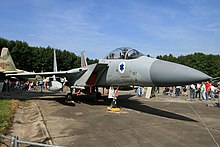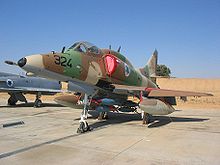1983 Negev mid-air collision
| Occurrence | |
|---|---|
| Date | 1 May 1983 |
| Summary | Mid-air collision |
| Site | Negev, Israel 30°50′48″N 34°50′52″E / 30.8467°N 34.8478°E |
| Total fatalities | 0 |
| Total survivors | 3 |
| First aircraft | |
 The Israeli Air Force F-15D Baz '957' involved in the incident, seen here in 2011 | |
| Type | McDonnell Douglas F-15D Eagle |
| Name | Markia Schakim |
| Operator | 106 Squadron Israeli Air Force |
| Registration | 957 |
| Flight origin | Tel Nof Airbase |
| Crew | 2 |
| Fatalities | 0 |
| Survivors | 2 |
| Second aircraft | |
 An Israeli Air Force A-4 Skyhawk similar to the one involved | |
| Type | Douglas A-4 Skyhawk |
| Operator | 116 Squadron Israeli Air Force |
| Registration | 374 |
| Flight origin | Nevatim Airbase |
| Crew | 1 |
| Fatalities | 0 |
| Survivors | 1 |
In May 1983, two
Accident
On 1 May 1983, during an Israeli Air Force dissimilar air combat training session over the Negev, an F-15D Eagle (called Baz (Falcon) by the Israelis) collided with an A-4 Skyhawk. The pilot of the Skyhawk was automatically ejected and his aircraft disintegrated. The right wing of the Eagle was sheared off roughly 2 ft (60 cm) from the root. The crew of the two-seat training version F-15, pilot Zivi Nedivi and navigator Yehoar Gal, did not initially realize the extent of the damage, as fuel leaking profusely and vaporizing at the wing attachment was obscuring their view of the area where the wing once was.[2][3][4]
The F-15 started rolling uncontrollably after the collision and the instructor ordered an ejection. Nedivi, who outranked the instructor, decided not to eject and attempted recovery by engaging the
Aftermath
The aircraft,
References
- ^ Leone, Dario (September 15, 2014). "How an Israeli F-15 Eagle managed to land with one wing". theaviationist.com. Retrieved June 2, 2016.
- ^ ISBN 978-1-84603-047-5.
- ^ a b Easley, Jon (August 9, 2001). "USS Bennington - crew stories - No Wing F15". www.uss-bennington.org. Retrieved September 30, 2010.
- ^ a b c "Heavy Metal: F-15". History Channel. Archived from the original on 2021-12-21. Retrieved September 30, 2010.
- ^ Antzikovsky, Eli. תאונת בז 957 "מרקיע שחקים" (in Hebrew). Sky-High.co.il. Archived from the original on March 3, 2016. Retrieved January 18, 2016.
